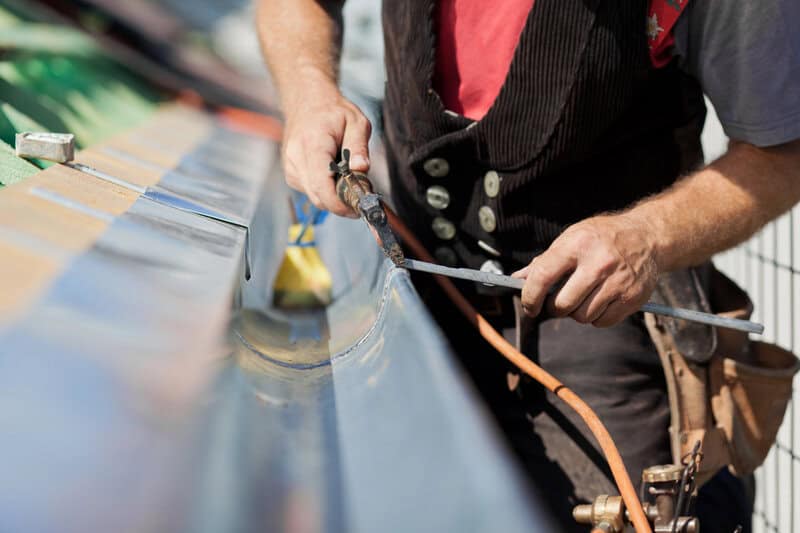
Any issues in your gutter system, including poorly installed or compromised gutter flashing, can make your home vulnerable to leaks and water damage. This is why annual roof inspections, including inspections and gutter/drainage system repairs, are recommended.
Gutter Flashing: An Integral Part Of Your Roofing System
Flashing is a general construction term that describes thin expanses of sheet metal – usually galvanized steel – installed where buildings are vulnerable to water penetration. While we may use sealant products for small penetrations, we install flashing for larger surface areas or expanses of water vulnerability.
In a residential roof system, we use flashing:
- In roof valleys (the space where two roof slopes meet one another)
- Around roof penetrations like chimneys, stove pipes, plumbing vents, skylights, etc.
- Where dormers or other protrusions connect with the roof’s surface.
- Wall flashing to protect the joint where the roof meets exterior walls.
- Drip edge flashing, which is attached to the edge of the roof where there aren’t any gutters – like the perimeter of a gable.
- Gutter flashing.
Gutter flashing is specific to the gutter and downspout system. It is installed over the joints where the roof edge meets the gutter. This ensures water moves from the roof slope and into the gutter system without being wicked under the shingles, tiles, or metal roof panels.
Gutter flashing is commonly made from galvanized steel because the material is lightweight, affordable, and corrosion-resistant. However, homeowners have options. Other gutter flashing materials include:
- Aluminum. Like galvanized steel, aluminum is lightweight and affordable. However, it requires a high-quality coating to withstand the salty sea air Bay Area homes are exposed to. It’s also not the best option if it’s coming into direct contact with masonry.
- Copper. While heavier than galvanized steel or aluminum gutter flashing, copper is an excellent choice for its durability and ease of workability. The most prohibitive feature is the price, as copper is costly. That said, it is a good choice for historical homes, and if you invest in copper flashing, odds are you’ll never need to replace it in your lifetime.
- Other materials. Roof and gutter flashing are also available in other materials, such as acrylic, plastic, rubber, and synthetics. However, these are not the most durable options, and we do not recommend them. We always stress quality over quantity when replacing your roof and its related systems.
A primary source of protection from leaks & water damage
Gutter flashing is designed to direct water from the roof into the gutter and downspout system, preventing it from making contact with any of the other structural materials that are vulnerable to water damage – like framing, drywall, insulation, etc. It is especially important for homes in climates like ours, where we have periods of heavy rain or constant moisture exposure from fog and drizzle during the winter and spring months.
Without flashing, water would make its way underneath your shingles or top-layer roofing materials. Other forms of water protection, like the roofing underlayment, are another layer of defense, but everything breaks down over time.
Water that doesn’t flow from the roof into the gutters also gets between the exterior wall layers, which means there can be considerable water damage on the insides of your exterior walls before you notice any signs of it.
Signs gutter flashing needs repair or replacement
High-quality flashing can outlast a roof. So, if you are faithful about observing annual roof maintenance, there is a chance your existing flashing can be used again, even if it’s time to replace the roof.
Signs it is time for new gutter flashing are:
- Your outdated roof has gutter flashing made from tar or roof cement rather than metal.
- Visible rust spots.
- Cracks.
- The roof is so visibly worn (sagging, rotting, damaged) that flashing is compromised.
If and when we can preserve roofing systems in good shape, we do.
How to maintain gutter flashing
The best way to monitor gutter flashing is to schedule an annual roof inspection. During the inspection, we’ll notice any signs that the gutter flashing is compromised. This gives us the chance to repair the flashing before corrosion or damage develops to the point that it needs to be replaced.
Gutter maintenance may be a DIY task you want to do yourself, and this also goes a long way towards preserving gutter flashing. The ongoing presence of roof debris (leaves, dirt, twigs, trash, etc.) can expedite roof rot. We recommend cleaning the gutters and flushing the downspouts seasonally. This keeps them free and clear so they can do their job and minimizes the chance of rotting debris eating its way into your roofing materials.
However, if you aren’t a DIYer, that’s no problem. Your roofing contractor, a licensed handyman, or professional gutter cleaning services are happy to do the job for you.
Schedule A Roof & Gutter Inspection With Pacific Coast Roofing
Are your gutters looking dilapidated? Can you see visible signs of corrosion or damage to your gutter flashing materials? It sounds like it’s time to schedule an inspection with Pacific Coast Roofing.
The sooner we address any issues affecting your gutter flashing or other aspects of the gutter and downspout system, the healthier your roof – and your home – will be. Contact us to schedule an inspection.
